Salesforce Bundle
Who Does Salesforce Serve?
Understanding the customer base is crucial for Salesforce's continued success. With innovations like Agentforce and significant AI investments, Salesforce has revolutionized customer relationship management (CRM). Founded in 1999, Salesforce initially focused on providing scalable, cloud-based CRM solutions, and its market position has since dramatically expanded.
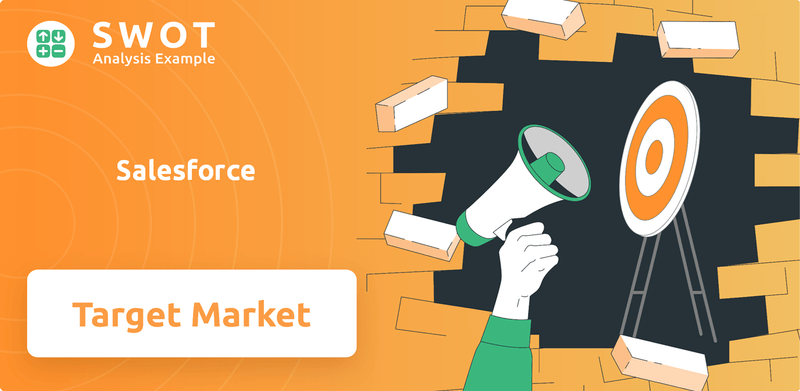
Salesforce's Salesforce SWOT Analysis reveals its deep understanding of its customer demographics and target market. Today, Salesforce is a leading cloud platform with a comprehensive suite of enterprise applications. Its dominant position in the global CRM market, holding a 21.7% market share in 2024, highlights its adaptability. This guide will delve into the Salesforce customer profile, exploring who uses Salesforce CRM, their needs, and how Salesforce continuously adapts its strategies to serve them, including the Salesforce ideal customer and their pain points.
Who Are Salesforce’s Main Customers?
Understanding the customer demographics Salesforce serves is crucial for grasping its market position. The company primarily focuses on business-to-business (B2B) clients, offering cloud-based solutions for customer relationship management (CRM) and a suite of enterprise applications. The Salesforce target market is diverse, spanning various industries and business sizes, making it a key player in the global CRM landscape.
As of 2024, Salesforce has over 150,000 customers worldwide. The company anticipates its customer base will double by the end of 2026. This growth underscores the company's expanding reach and the increasing demand for its services across different sectors. The Salesforce customer profile is a broad one, encompassing small businesses to large enterprises.
This diverse customer base is a testament to the adaptability and scalability of its offerings, making it a preferred choice for businesses of all sizes and across various industries. The company's ability to cater to a wide range of needs has solidified its position as a leader in the CRM market.
Salesforce users are spread across numerous industries. Professional services, including legal, advertising, and accounting firms, make up a significant portion, around 29% of the customer base. Other core segments include manufacturing (11.1%), banking and financial services (9.8%), and retail (7.8%).
The Salesforce customer size varies widely. Approximately 49% of its clients are small businesses (fewer than 50 employees), 40% are medium-sized businesses (50-1000 employees), and 11% are large enterprises (over 1000 employees). This distribution highlights the platform's versatility, catering to both emerging and established businesses.
Beyond the core sectors, Salesforce also serves industries such as consumer packaged goods, media, energy & utilities, public sector, travel & hospitality, education, healthcare & life sciences, nonprofit, communications, and automotive. This broad industry reach demonstrates its adaptability and the widespread applicability of its CRM solutions.
Salesforce's enterprise clients include major corporations. Approximately 80% of Fortune 500 companies utilize Salesforce. Notable large customers include Walmart Inc., Amazon Web Services (AWS), IBM, NASA, Unilever, Mercedes-Benz, and U.S. Bank. This highlights the platform's scalability and enterprise-grade security.
The Salesforce ideal customer often includes businesses seeking to improve customer relationships, streamline sales processes, and enhance overall operational efficiency. The platform is particularly prevalent among smaller companies with annual revenues between $1 million and $10 million. The company's focus on innovation and industry-specific solutions helps it cater to the evolving Salesforce customer needs.
- Businesses looking for scalable CRM solutions.
- Companies aiming to improve customer service and sales performance.
- Organizations needing robust data analytics and reporting capabilities.
- Enterprises seeking industry-specific cloud solutions.
Salesforce SWOT Analysis
- Complete SWOT Breakdown
- Fully Customizable
- Editable in Excel & Word
- Professional Formatting
- Investor-Ready Format
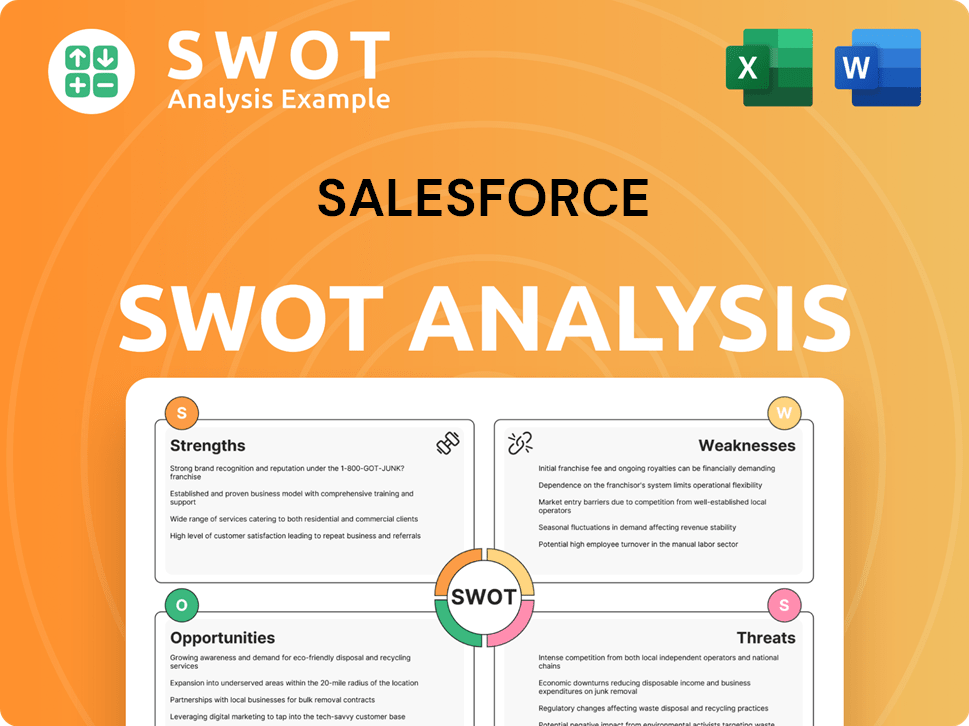
What Do Salesforce’s Customers Want?
Understanding the customer needs and preferences is crucial for any business, and for Salesforce, this means focusing on how they can help their clients enhance customer relationships, streamline operations, and leverage data effectively. Businesses are drawn to Salesforce for its user-friendly design, robust security features, and ability to accommodate international compliance standards, along with the flexibility to create customized systems. A key driver for adopting Salesforce is the need for a unified view of customer interactions, which the Customer 360 platform addresses directly.
Salesforce's success is rooted in its ability to provide comprehensive solutions, real-time insights, and automation capabilities. Customers seek tools that can predict their needs, automate routine tasks, and offer deeper insights into customer data. Salesforce's Einstein AI capabilities are designed to meet these demands. Companies are increasingly using AI-powered analytics to gain personalized customer insights and automate repetitive processes to boost efficiency. Psychological and practical drivers include improving lead segmentation, enhancing the analysis of anticipated consumer behavior, and automating sales outreach and email marketing.
Salesforce addresses common pain points like fragmented customer data, long sales cycles, and customer churn. The company's product development is heavily influenced by continuous customer feedback and market trends, particularly the accelerating adoption of AI. Salesforce has made significant investments in AI, including a $1 billion investment to enhance its AI capabilities and workforce, and launched Agentforce, a suite of autonomous AI agents designed to redefine business operations by handling tasks independently. This innovation directly responds to the customer need for increased efficiency and reduced manual intervention.
Salesforce's Customer 360 platform offers a unified view of customer interactions across all platforms, which is a primary driver for businesses. This helps connect sales, service, marketing, and commerce departments.
Salesforce's Einstein AI capabilities provide real-time insights and automation, helping customers predict needs and streamline operations. Businesses are increasingly using AI to gain personalized customer insights and automate processes.
Salesforce tackles common customer pain points such as fragmented data, long sales cycles, and customer churn. It influences product development through customer feedback and market trends, especially the adoption of AI.
Salesforce uses AI-generated data insights for hyper-personalization, understanding and addressing individual customer preferences. This includes delivering tailored content and creating omnichannel experiences for consistent communication.
Agentforce is a suite of autonomous AI agents designed to redefine business operations by handling tasks independently. This innovation responds to the customer need for increased efficiency and reduced manual intervention.
Salesforce tailors its marketing and product features through hyper-personalization, using AI-generated data insights to understand and address individual customer preferences, delivering tailored content and offers.
Salesforce's Salesforce customer profile is shaped by the need for unified customer views, AI-powered solutions, and the ability to address common pain points. Understanding these needs is key to Salesforce's success.
- Customer Demographics Salesforce targets a broad range of industries, including financial services, healthcare, retail, and manufacturing.
- Salesforce target market includes businesses of all sizes, from small businesses to large enterprises, with a focus on those needing CRM and cloud solutions.
- Salesforce users seek solutions that improve customer relationships, streamline operations, and leverage data for strategic decision-making.
- Salesforce ideal customer values user-friendly design, robust security, and the ability to customize systems to fit specific business needs.
- Salesforce client base is diverse, reflecting the wide applicability of its products across various sectors.
Salesforce PESTLE Analysis
- Covers All 6 PESTLE Categories
- No Research Needed – Save Hours of Work
- Built by Experts, Trusted by Consultants
- Instant Download, Ready to Use
- 100% Editable, Fully Customizable
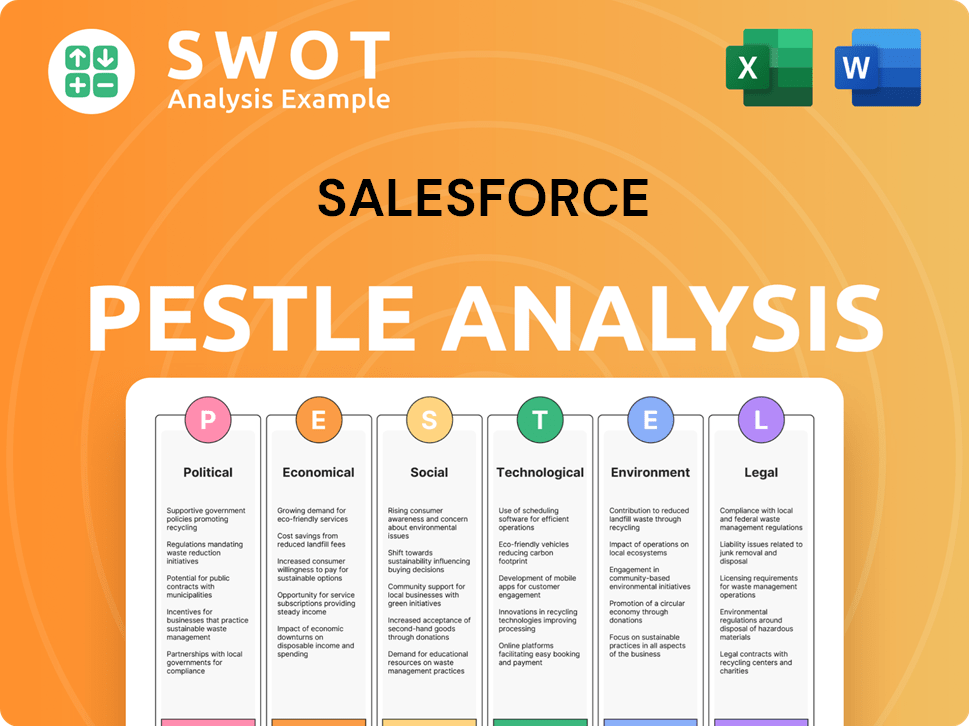
Where does Salesforce operate?
The geographical market presence of Salesforce is a key factor in its global success. The company strategically targets the Americas, Europe, and Asia-Pacific regions. These areas are vital for revenue generation and customer acquisition, reflecting Salesforce's commitment to a worldwide footprint.
The Americas consistently contribute the largest share of Salesforce's revenue. Europe and Asia-Pacific also play significant roles, driven by the adoption of cloud-based CRM solutions. This global reach allows Salesforce to cater to diverse customer needs and preferences across different markets.
Salesforce's revenue in the Americas reached $23.29 billion in fiscal year 2024, accounting for 66.81% of its total revenue. Projections for fiscal year 2025 estimate this to grow to $25.14 billion. Europe is the second-largest market, with $8.13 billion in revenue in 2024, and is expected to reach $8.89 billion in 2025. The Asia-Pacific region generated $3.44 billion in 2024, representing approximately 10% of Salesforce's overall global revenue, and is projected to reach $3.86 billion in 2025.
Salesforce holds the top position in the CRM market across North America, Latin America, Western Europe, and Asia-Pacific (including Japan). This dominance has been maintained for 12 consecutive years as of April 2025, highlighting its strong market presence and customer trust.
Approximately 50% to 59% of Salesforce's CRM customers are based in the United States. This region also generates the highest revenue for the company, underscoring the importance of the U.S. market in Salesforce's overall strategy.
Understanding the specific needs of the Salesforce users in each region is crucial. Salesforce tailors its offerings, marketing strategies, and partnerships to suit the unique characteristics of each market. For instance, the company's expansion into India involved introducing more affordable CRM solutions, contributing to significant revenue growth. For additional insights, consider exploring the Competitors Landscape of Salesforce.
As of March 31, 2024, Salesforce's revenue in India was approximately $1.104 billion. This marked a 36% growth compared to the previous year, driven by strategic initiatives.
Salesforce has announced a $1 billion investment in Singapore over the next five years. This investment aims to foster digital transformation and support the local economy.
A $500 million investment in Saudi Arabia for AI-related projects reflects Salesforce's commitment to innovation and regional growth. This includes initiatives to upskill the local workforce.
Salesforce adapts its offerings and marketing to suit the specific needs of each region. This localized approach helps the company to succeed in diverse markets and build stronger customer relationships.
Salesforce focuses on a diverse range of industries and customer sizes. This includes small businesses, enterprises, and various sectors, ensuring a broad market reach.
Salesforce segments its customers based on various factors, including industry, size, and location. This segmentation helps in delivering tailored solutions and improving customer satisfaction.
Salesforce Business Model Canvas
- Complete 9-Block Business Model Canvas
- Effortlessly Communicate Your Business Strategy
- Investor-Ready BMC Format
- 100% Editable and Customizable
- Clear and Structured Layout
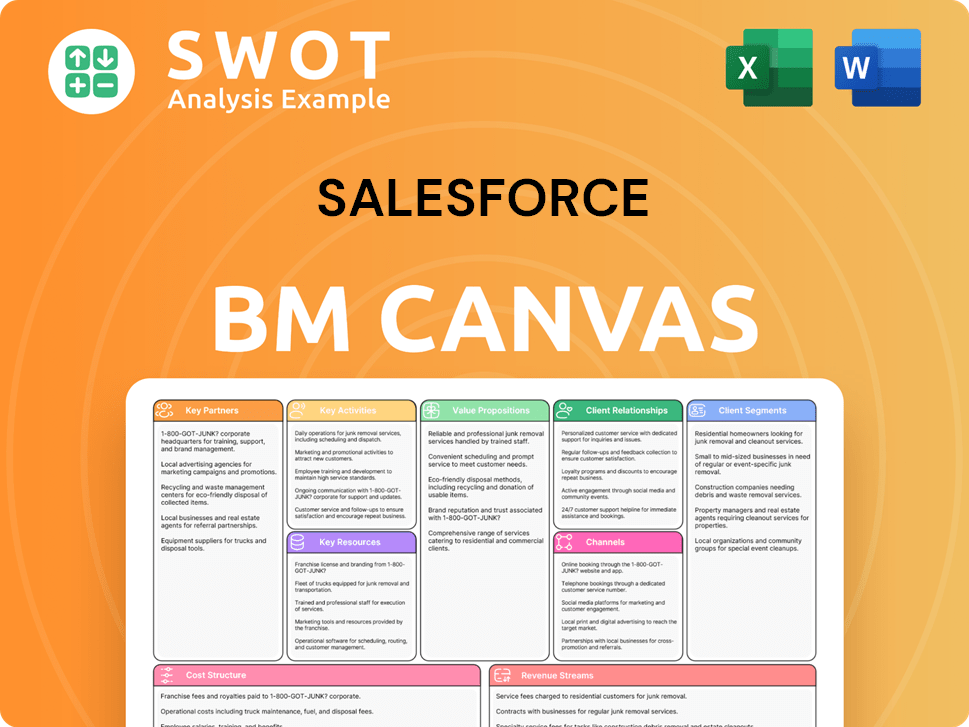
How Does Salesforce Win & Keep Customers?
The company focuses on a multi-faceted approach to both acquiring and retaining customers, utilizing its comprehensive CRM platform and embracing technological advancements. For customer acquisition, the company assists businesses in streamlining sales processes, automating marketing campaigns, and nurturing leads through personalized messaging. They also facilitate the creation of seamless omnichannel shopping experiences.
Key strategies for customer acquisition include digital marketing, social media engagement, and strategic partnerships. The company's AppExchange marketplace, featuring over 5,000 apps, plays a crucial role by offering third-party integrations to personalize CRM systems, expanding the ecosystem beyond typical CRM functionalities. Customer retention is a significant focus, as it is more cost-effective than acquiring new customers and leads to increased revenue and enhanced brand reputation.
The company emphasizes building strong, long-term relationships by consistently delivering value through excellent customer service. This involves strategies such as customer segmentation, personalized interactions, loyalty programs, proactive customer support, and the integration of AI and automation. The company's approach is evolving with the increasing integration of AI, transforming customer interactions and redefining customer relationship management.
The company uses a robust customer acquisition strategy centered around its CRM platform. This includes streamlining sales processes, automating marketing efforts, and nurturing leads with personalized communications. The company also enables businesses to build omnichannel shopping experiences.
Key tactics include digital marketing, social media engagement, and strategic partnerships. The AppExchange marketplace is also a critical component, offering over 5,000 apps that allow users to personalize their CRM systems, thereby expanding the ecosystem.
Customer retention is a high priority for the company, as it's more cost-effective than acquiring new customers. This approach leads to increased revenue and enhances brand reputation. The company focuses on building strong, long-term relationships with its clients.
The company uses strategies like customer segmentation, personalized interactions, loyalty programs, and proactive customer support to retain customers. AI and automation are also key components, enhancing customer experiences and boosting efficiency.
The company uses several strategies to retain customers, including customer segmentation, personalized interactions, and loyalty programs. Proactive customer support is also a key element, with AI and automation playing an increasingly significant role.
- Customer Segmentation: Dividing the customer base into distinct segments based on demographics, purchase history, or engagement patterns to create targeted campaigns using CRM and Marketing Cloud.
- Personalized Interactions: Leveraging CRM to collect customer data and insights, then using Marketing Cloud to deliver personalized content, offers, and recommendations based on individual attributes and interests.
- Loyalty Programs: Developing and implementing loyalty programs to reward ongoing business, with CRM used to track behavior and rewards, and Service Cloud supporting management and redemption.
- Proactive Customer Support: Utilizing Service Cloud to monitor interactions and inquiries, proactively reaching out with solutions, updates, or tips before issues escalate. This includes providing 24/7 support and various customer service channels.
- AI and Automation: Implementing AI-powered analytics for personalized customer insights, automating repetitive processes to boost efficiency, and utilizing AI-driven chatbots to enhance customer support and engagement.
The company is significantly integrating AI to transform how businesses interact with customers. This includes agentic AI, where self-learning AI agents manage routine customer support and streamline sales funnels. This shift is expected to redefine customer relationship management in 2025.
The introduction of Agentforce, a suite of autonomous AI agents, is poised to further enhance customer service automation by handling tasks independently. This is a significant step in leveraging AI for customer support.
The company's strategy is increasingly focused on data-driven insights and enhanced customer experiences. This approach allows for more personalized and effective customer interactions. The focus is on delivering value through every interaction.
By focusing on retention and providing excellent customer service, the company aims to increase customer lifetime value. This strategy ensures long-term profitability and strengthens customer relationships. Understanding the Brief History of Salesforce helps to see how it has evolved.
Salesforce Porter's Five Forces Analysis
- Covers All 5 Competitive Forces in Detail
- Structured for Consultants, Students, and Founders
- 100% Editable in Microsoft Word & Excel
- Instant Digital Download – Use Immediately
- Compatible with Mac & PC – Fully Unlocked
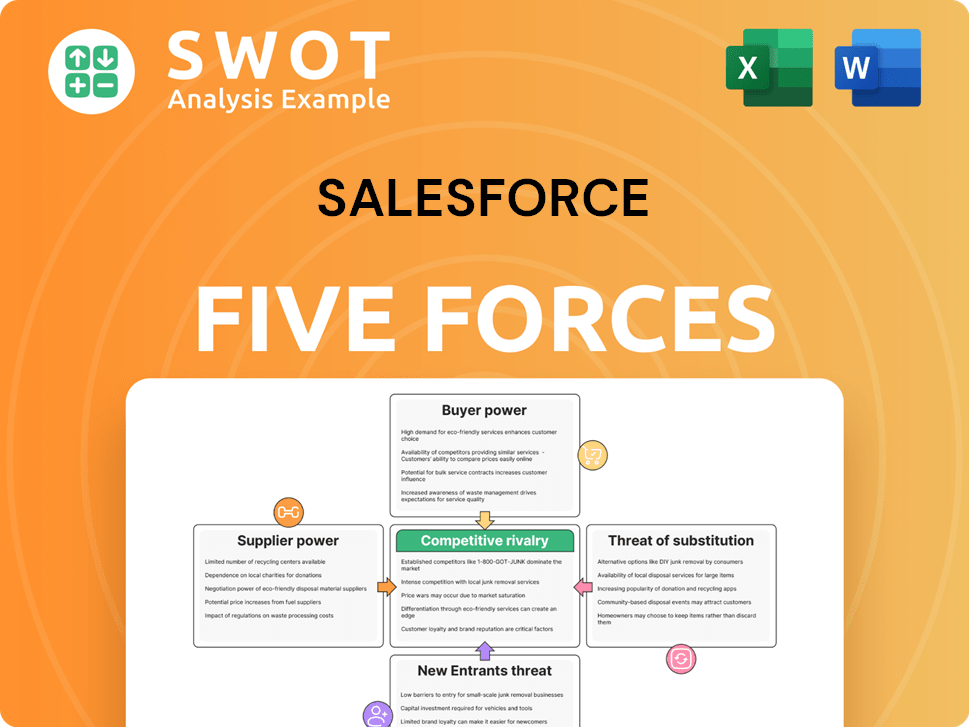
Related Blogs
- What are Mission Vision & Core Values of Salesforce Company?
- What is Competitive Landscape of Salesforce Company?
- What is Growth Strategy and Future Prospects of Salesforce Company?
- How Does Salesforce Company Work?
- What is Sales and Marketing Strategy of Salesforce Company?
- What is Brief History of Salesforce Company?
- Who Owns Salesforce Company?
Disclaimer
All information, articles, and product details provided on this website are for general informational and educational purposes only. We do not claim any ownership over, nor do we intend to infringe upon, any trademarks, copyrights, logos, brand names, or other intellectual property mentioned or depicted on this site. Such intellectual property remains the property of its respective owners, and any references here are made solely for identification or informational purposes, without implying any affiliation, endorsement, or partnership.
We make no representations or warranties, express or implied, regarding the accuracy, completeness, or suitability of any content or products presented. Nothing on this website should be construed as legal, tax, investment, financial, medical, or other professional advice. In addition, no part of this site—including articles or product references—constitutes a solicitation, recommendation, endorsement, advertisement, or offer to buy or sell any securities, franchises, or other financial instruments, particularly in jurisdictions where such activity would be unlawful.
All content is of a general nature and may not address the specific circumstances of any individual or entity. It is not a substitute for professional advice or services. Any actions you take based on the information provided here are strictly at your own risk. You accept full responsibility for any decisions or outcomes arising from your use of this website and agree to release us from any liability in connection with your use of, or reliance upon, the content or products found herein.